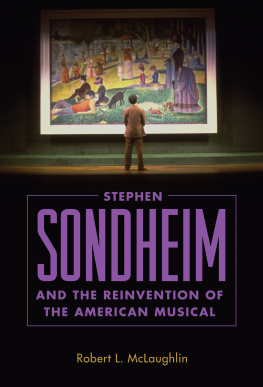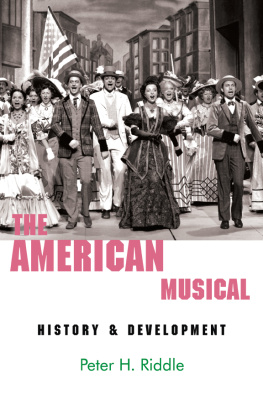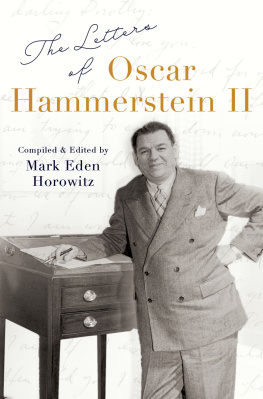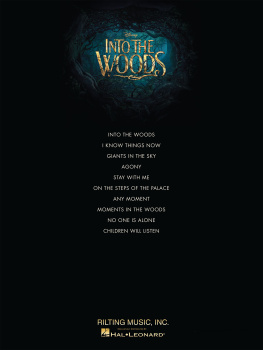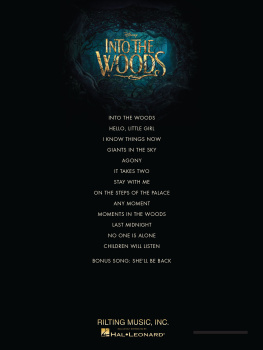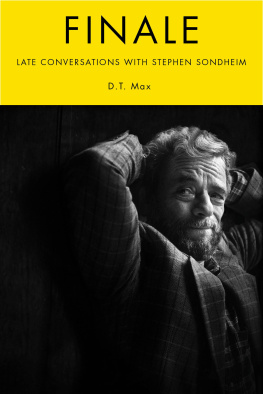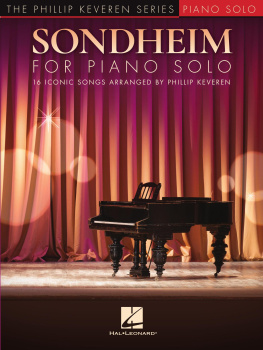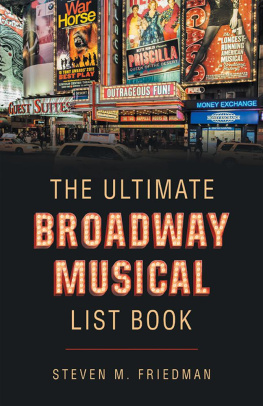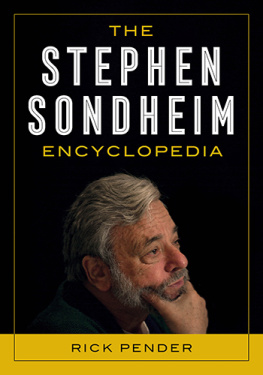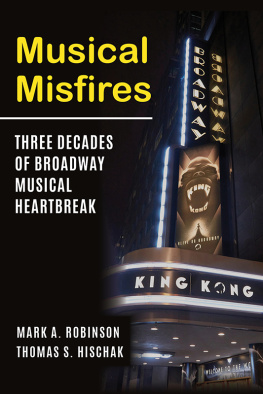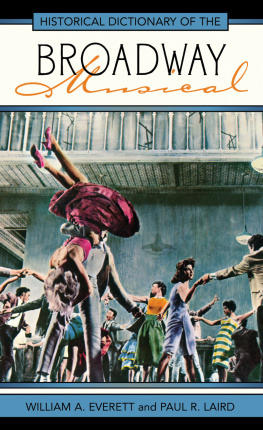
STEPHEN SONDHEIM AND THE REINVENTION OF THE AMERICAN MUSICAL
Stephen Sondheim and the Reinvention of the American Musical
Robert L. McLaughlin
University Press of Mississippi Jackson
www.upress.state.ms.us
The University Press of Mississippi is a member of the Association of American University Presses.
Copyright 2016 by University Press of Mississippi
All rights reserved
Manufactured in the United States of America
First printing 2016
Library of Congress Cataloging-in-Publication Data
Names: McLaughlin, Robert L., 1957 author.
Title: Stephen Sondheim and the Reinvention of the American Musical / Robert L. McLaughlin.
Description: Jackson : University Press of Mississippi, 2016. | Includes bibliographical references and index.
Identifiers: LCCN 2016004207 (print) | LCCN 2016005505 (ebook) | ISBN 9781496808554 (cloth : alk. paper) | ISBN 9781496808561 (epub single) | ISBN 9781496808578 (epub institutional) | ISBN 9781496808585 (pdf single) | ISBN 9781496808592 (pdf institutional)
Subjects: LCSH: Sondheim, StephenCriticism and interpretation. | MusicalsUnited StatesHistory and criticism.
Classification: LCC ML410.S6872 M36 2016 (print) | LCC ML410.S6872 (ebook) | DDC 782.1/4092dc23
LC record available at http://lccn.loc.gov/2016004207
British Library Cataloging-in-Publication Data available
CONTENTS
PREFACE
Generally they see things that arent there. But I dont want to make fun of them. Its nice to be taken seriously.
Stephen Sondheim, on scholarly studies of his work.
This book takes Stephen Sondheim seriously. More specifically, it attempts to put Sondheims work in conversation with its cultural moment. The two preceding sentences are more complicated than they may appear.
The first complication is the notion of seriousness as applied to the musical theater. I begin from the premise that the musical theater can be studied with the same academic methods and intellectual rigor that are routinely applied to other art formsliterature, drama, film, operaand other popular-culture formsTV, music videos, computer games. Sadly, there is still resistance in the academic world to the thought that the musical theater is a worthy subject for scholarly study. I hope this book will collaborate with other recent work to demonstrate that the musical theater can not only sustain the weight of scholarly scrutiny but also reward that scrutiny.
This is not to say that this book is dryat least I hope it isnt. This project has been a labor of love in the sense that in it I bring together two different kinds of (almost) lifelong loves. The main focus of my academic career has been postmodern literature and culture, especially postmodern fiction, especially the work of Thomas Pynchon. This literature has fed my enthusiasm for the experimental and new, for the kind of literature that breaks the rules so as to suggest other ways of seeing and being in the world beyond the ones that have been officially defined for us. My other love, for the musical theater, began long before I imagined myself as an academic, when the national tour of 1776 came to Rochester, New York. I had seen stage musicals beforethe one that stands out is Oliver!and enjoyed them, but what I had enjoyed was the story, the book; when the characters started singing, I waited impatiently for the dialogue to start again. But 1776 was different, or I was different: I not only enjoyed the songs but also understood how they were helping tell the story, define the characters, and develop the themes; I was surprised and delighted by the way this musical took figures I knew only from statues and textbooks and turned them into real people. I had to have the cast recording, and I soon began collecting the cast recordings of other showsclassics like the Rodgers and Hammerstein canon, My Fair Lady, Fiddler on the Roof, West Side Storyand reading scripts and histories of the musical theater. (I had David Ewens New Complete Book of the American Musical Theater perpetually checked out of the Avon Free Library.) One day I saw the cast recording of Company in the library: I hadnt heard of the show, but I recognized the name Stephen Sondheim from the album of West Side Story, so I took it home. The opening number, with its overlapping voices calling out to Bobby, was like nothing Id heard before. Soon after, I saw the double album Sondheim: A Musical Tribute (the Scrabble album) in the record bin at Woolworths, bought it, and was completely and forever hooked. I chose a college in New York City not least so that I could finally see Broadway shows, and I joined my universitys theater club so that I could act and sing myself. Seventeen years after my last college performance, after earning my graduate degrees, after moving to central Illinois, after pretty much ensuring my tenure, I auditioned for a local community theaters production of A Little Night Music simply because Id never had the chance to be in a Sondheim musical. Ive been in several more of his musicals since. My point here is that while my academic interests have focused on postmodern literature, my interest in and love for the musical theater and for Stephen Sondheims words and music have never been far in the background. In fact, over the years Ive thought more and more about the connections between the twopostmodern literature and Sondheims work. Ive written a couple of articles and conference presentations on Sondheim, but this book is my most serious attempt to bring the two together, to use postmodernism as a frame through which to look at the musical theater and the plays of Sondheim and his collaborators and to see what new ways of understanding them this approach can offer.
The second complication from my opening sentences has already reared its head in the previous two paragraphs: the problem of Sondheims work. The musical theater is necessarily a collaborative enterprise. When librettists, lyricists, composers, directors, choreographers, designers, and actors collaborate on a musical, their individual contributions can be impossible to parse out from the final product, the show on the stage. There are no strict boundaries between a musicals areas of responsibilities. Stephen Sondheim has been generously insistent in crediting his collaborators, bristling, for example, in letters to the New York Times when an article refers to a Sondheim musical without mentioning the librettist. When he received a Lifetime Achievement Award from the Tony Awards in 2008, his acceptance speech began,
Thank you all, but this award has to be shared with Julius Epstein, Arthur Laurents, Burt Shevelove, Larry Gelbart, George Furth, Jim Goldman, John Weidman, Hugh Wheeler and James Lapine. These are the men who created the characters that sang the songs, the situations that gave rise to the songs and the criticism that improved the songs. They were my collaborators. They are called playwrights. They invent. They make whole cloth out of nothing. They make a hat where there never was a hat. And they dont just write musicals. I would also share this Award with Hal Prince, but he has one already.
This book, for reasons explained in the following, focuses on the musicals of Stephen Sondheim, but it recognizes that these musicals are not solely the product of Sondheims imagination, thought, and talent. In concentrating on Sondheims oeuvre, I am not belittling the contributions of his collaborators, theater giants in their own right. Nor am I going to try to separate Sondheims music and lyrics from the rest of the play (no brilliant-score-troubled-book readings). I will consider each play as a whole, and there will be times when my attention will be focused on elements of a play that might not seem to be, strictly speaking, Sondheims contribution. Finally, although I strive to give proper credit to each plays creators, there are times when, for efficiencys sake, I refer to Sondheims plays or Sondheims musicals. Please accept that I do this with the understanding that these plays are not Sondheims alone. After all, no one is alone.
Next page
